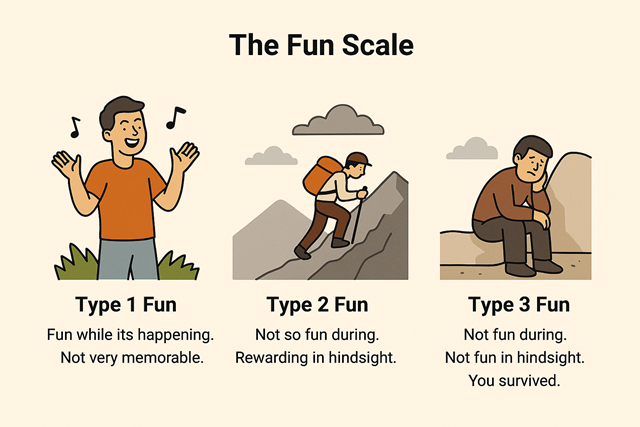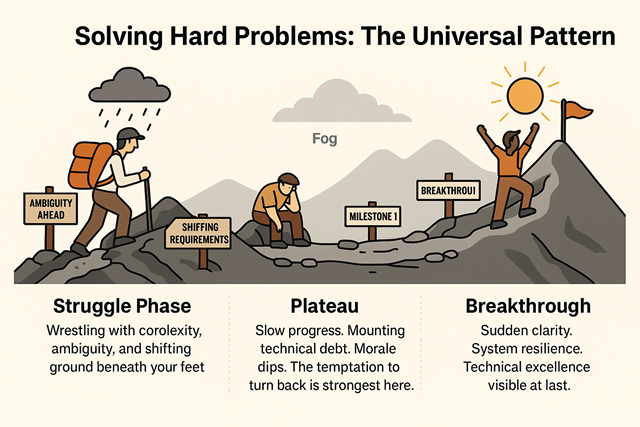There's a concept in outdoor adventure circles called "Type 2 Fun." Unlike Type 1 Fun (immediately enjoyable activities), Type 2 Fun is often not fun at all while you're doing it but becomes enjoyable in retrospect.
I discovered this firsthand during my first half-marathon. Mile 10 was pure agony—legs burning, lungs screaming, mind begging me to stop. Nothing about that moment felt "fun." Yet crossing the finish line delivered a satisfaction that immediate pleasures rarely provide. Looking back, that gruelling experience transformed into one of my proudest memories.
This paradox perfectly describes the reality of engineering leadership in startups.

The Myth of Overnight Technical Success
We're inundated with stories of technical breakthroughs that seem to materialise from thin air. The elegant architecture that scales effortlessly. The codebase that never accumulates technical debt. The team that ships features without missing deadlines.
Look behind the curtain, and you'll find a different reality:
- Stripe's "elegant" API evolved through countless iterations and years of refinement before becoming the industry standard.
- Slack emerged from the ashes of a failed gaming company, repurposing their internal communication tool after their primary product faltered.
- Netflix's renowned microservices architecture came after years of painful migration from their monolithic system—a process that took nearly two years of concentrated effort.
Solving Hard Problems: The Universal Pattern
Success in engineering leadership follows a predictable pattern that's rarely visible in tech conference talks:
- The Struggle Phase: Wrestling with ambiguity, making architectural decisions with incomplete information, building foundations while business requirements shift beneath you.
- The Plateau: The most dangerous moment—where codebase complexity increases but visible progress decreases despite continued effort.
- The Breakthrough: What appears to outsiders as an overnight engineering triumph but is actually the culmination of countless debugging sessions, refactors, and hard-won lessons.
The plateau phase is where most engineering initiatives fail. The excitement of greenfield development has faded, technical debt accumulates, and progress slows to a crawl. It's where ambitious rewrite projects go to die and where promising startups often lose momentum.
Embracing the Hard Technical Challenges
The most valuable technical achievements are inherently difficult. Building scalable architectures. Maintaining system reliability. Creating intuitive user experiences. Balancing feature velocity with code quality. Leading teams through uncertainty.
What separates successful technical leaders isn't superior intellect or clairvoyant architectural vision—it's the resolve to persist when uncertainty is highest and progress seems most elusive.
Perseverance in engineering isn't glamorous. It's diving into production issues at 2 AM. It's carefully refactoring critical paths while keeping systems online. It's maintaining team morale when deadlines shift and requirements evolve. It's making decisions with incomplete information and adjusting as new data emerges.
Practical Applications for Engineering Leaders
How can we apply this understanding to technical leadership?
- Expect uncertainty and complexity. When starting a new technical initiative, mentally prepare for the inevitable challenges. Don't be surprised when simple solutions prove insufficient.
- Connect to mission. When technical problems seem insurmountable, reconnect with the customer problem you're solving. Technical excellence serves human needs.
- Decompose complex problems. Focus on the next service to refactor, not the entire system. The next feature, not the entire roadmap. Small, consistent improvement compounds.
- Celebrate technical milestones. Progress in engineering is rarely linear. Acknowledge achievements in code quality, performance improvements, and technical debt reduction—even when users can't see them.
- Build engineering communities. Share challenges with other technical leaders. Their perspective during architectural decision points is invaluable.
The next time you face a seemingly impossible technical challenge, remember: hard engineering problems are hard for everyone. That's what makes solving them worthwhile. And perseverance—continuing despite complexity and uncertainty—is what transforms the impossible into the achieved.
The deployment of an elegant solution that withstands the test of scale is worth it. It just takes a little patience.
